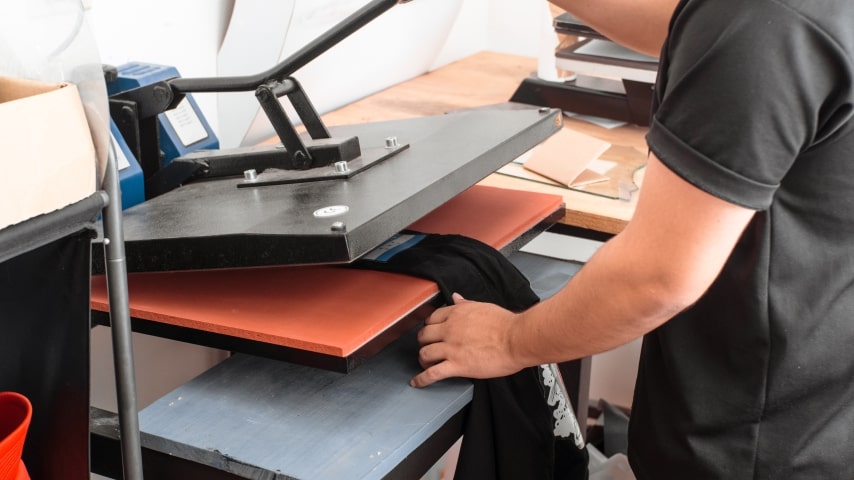A Comprehensive Guide to the Various Kinds Of Fabric Printing Techniques
Starting an exploration of fabric printing strategies exposes a remarkable intersection of custom and development. Each approach, from the meticulous workmanship of block printing to the quick efficiency of display printing, offers unique functions and supplies distinct benefits. Digital printing's adaptability and ecological awareness stand in stark contrast to the quick modification of heat transfer printing. On the other hand, color sublimation printing astounds with its ability to produce vibrant, long-lasting designs on artificial materials. To genuinely realize the subtleties and possible applications of these diverse strategies, a deeper investigation is vital.
Block Printing
Block Printing, one of the earliest methods of textile design, has a rich background that dates back to old worlds. The process entails carving intricate layouts into wooden blocks, which are after that dipped in color and pressed onto textile to produce patterns.
The precision and workmanship included in block printing make it a labor-intensive process, yet it likewise permits a high level of personalization. Artisans can develop distinct patterns by combining various blocks or varying the application of color. This flexibility has actually contributed to the long-lasting popularity of block printing in both standard and contemporary fabric design.
Block printing is specifically valued for its aesthetic top qualities, including the slight variants in pattern and shade that arise from the hand-printing process. These flaws offer a special personality to every item, distinguishing it from mass-produced textiles. Despite developments in modern printing innovations, obstruct printing remains a treasured strategy, celebrated for its historic significance and creative worth.
Display Printing
Screen printing, another noticeable fabric decoration method, has actually transformed the market with its performance and flexibility. This technique involves creating a pattern, referred to as a screen, and using it to use layers of ink on the printing surface area. Each color in the layout calls for a different display, which permits for dynamic and detailed multi-colored prints.

One of the vital benefits of display printing is its adaptability to numerous sorts of fabrics, including cotton, polyester, and blends. This technique is especially ideal for large-volume orders because of its cost-effectiveness and speed. The longevity of the prints is another significant benefit, as the ink bonds well with the fabric, making sure lasting layouts that withstand multiple washes.
Once dried, the style is transferred onto the emulsion-coated screen making use of a UV light resource. Ink is then pushed with the stencil onto the fabric utilizing a squeegee.
Screen printing is extensively made use of in the garment industry, marketing items, and custom clothing. Its ability for high-grade, comprehensive prints secures its condition as a keystone method in fabric printing.
Digital Printing
Digital printing has actually swiftly emerged as a sophisticated technique in the textile industry, leveraging advanced modern technology to generate high-resolution styles directly onto textile. Unlike standard techniques, digital printing uses inkjet printers to deposit pigment or dye-based inks onto textiles, allowing vibrant and elaborate patterns with a remarkable degree of detail and shade precision.
One of the key benefits of electronic printing is its adaptability. This technique enables on-demand printing, which dramatically decreases waste and decreases stock prices. In addition, it sustains short runs and custom-made designs, making it perfect for bespoke jobs and limited-edition collections. The removal of screens and other setup demands further improves performance, lowering manufacturing time and labor costs.
Moreover, digital printing is eco-friendly. Branded clothing. It uses water-based inks and requires less water and power contrasted to conventional techniques, lining up with lasting practices. The accuracy of digital printing also permits the use of a wider variety of materials, including cotton, silk, polyester, and blends, making sure adaptability across different applications
Heat Transfer Printing
Just how does warmth transfer printing revolutionize textile design? This technique has actually brought significant developments by permitting vivid and elaborate styles to be moved onto a selection of fabrics with exceptional accuracy. Warmth transfer printing includes using warmth and pressure to transfer a layout from a specifically developed paper onto material. This process begins with publishing the desired photo onto transfer paper utilizing specialized inks. Once the picture is published, the paper is put onto the fabric and based on a warm press, which moves the ink from the paper to the fabric.
Among the main benefits of warmth transfer printing is its capability to generate top quality, detailed photos rapidly and effectively. It is specifically fit for small production runs and personalized orders, making it a popular selection for tailored garments and marketing products. Additionally, this method is versatile, fitting various kinds of fabrics consisting of cotton, polyester, and blends.
Moreover, warmth transfer printing is reasonably affordable compared to various other methods, as it requires very little arrangement and reduced preliminary investment - sublimation printing. This cost, paired with its capacity for producing my website vivid, durable prints, highlights its pivotal role in modern fabric design

Dye Sublimation Printing
Dye sublimation printing, an advanced textile printing strategy, offers unequaled vibrancy and long life for layouts on various artificial textiles. The printed transfer paper is after that placed on the fabric, and both are subjected to high warmth and pressure utilizing a warm press.
One of the crucial advantages of color sublimation printing is its ability to produce continuous-tone prints with detailed information and dynamic shades. Unlike various other printing techniques, the color ends up navigate to these guys being component of the material rather than resting on top of it, resulting in a breathable and soft coating.
Final Thought
In summary, fabric printing strategies each offer one-of-a-kind benefits customized to various demands and applications. Block printing is revered for its artisanal high quality, while screen printing is helpful for high-volume production. Digital printing supplies flexibility and ecological benefits, whereas warmth transfer printing is excellent for fast modification. Dye sublimation printing creates vibrant, durable layouts on artificial fabrics. The variety and technology within these approaches highlight the vibrant and progressing nature of the towel printing market.
Each technique, from the precise workmanship of block printing to the rapid effectiveness of screen printing, offers special functions and uses distinct benefits. Digital printing's adaptability and ecological awareness stand in stark comparison to the speedy modification of heat transfer printing. Despite advances in modern printing modern technologies, obstruct printing stays a treasured technique, commemorated for its historic importance and artistic worth.
Dye my blog sublimation printing, an advanced textile printing method, provides unparalleled vibrancy and durability for designs on numerous synthetic fabrics. Digital printing offers versatility and environmental benefits, whereas warmth transfer printing is suitable for quick modification.